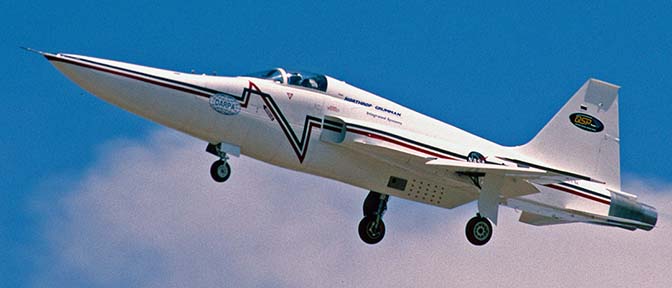 (Download a higher resolution
picture by clicking on any picture below.)
(Download a higher resolution
picture by clicking on any picture below.)
F-5 Shaped Sonic Boom Demonstrator spotted at Palmdale, August 25, 2003 |
 (Download a higher resolution
picture by clicking on any picture below.)
(Download a higher resolution
picture by clicking on any picture below.)
DARPA and NASA are investigating a method of shaping the sonic boom generated by a supersonic airplane to reduce the overpressure to acceptable levels for flight over populated areas. A Northrop-Grumman F-5 has been fitted with a glove over its nose for tests of the effectiveness of the method.
The F-5 Shaped Sonic Boom Demonstrator (SSBD) made a series of flights from Air Force Plant 42 at Palmdale, California during the week of August 25 - 29. The flights took it to Harper Dry Lake, where an array of pressure sensors has been assembled to monitor sonic boom overpressures. Baseline data has been collected from conventional supersonic fighters. A NASA F-15B equipped with pressure sensors collected data as it flew through the shock wave streaming from the F-5 SSBD.
Shortly before 11:00 A.M. on Monday, August 25, the NASA F-15B and a NASA F/A-18B chase plane approached Palmdale Airport from the east. They flew over the field and then circled to catch the F-5 SSBD as it took off.
 NASA F-15B chase plane flies over the airfield
as the F-5 SSBD crosses the horizon after taking off.
NASA F-15B chase plane flies over the airfield
as the F-5 SSBD crosses the horizon after taking off.
 The white underside of the F-5 SSBD reflects
the red soil of the desert as it passes over Sierra Highway.
Aside from havin a longer nose, it does not appear remarkably
different from a standard F-5 from this angle.
The white underside of the F-5 SSBD reflects
the red soil of the desert as it passes over Sierra Highway.
Aside from havin a longer nose, it does not appear remarkably
different from a standard F-5 from this angle.
 NASA's F-15B and F/A-18B chase planes turn to
the north as the F-5 SSBD joins their formation.
NASA's F-15B and F/A-18B chase planes turn to
the north as the F-5 SSBD joins their formation.
 The F-5 SSBD joins up with NASA's
F-15B and F/A-18B chase planes.
The F-5 SSBD joins up with NASA's
F-15B and F/A-18B chase planes.
The chase planes were later seen flying behind a Boeing KC-135 Stratotanker over the Palmdale Airport. About forty minutes after taking off, the F-5SSBD returned to the airport. It flew over the airfield and then banked to the left to enter the landing pattern.
 F-5 SSBD on approach to landing. The nose glove extends the
length of the fuselage and nearly doubles its cross-sectional
area. The aircraft is a modified F-5E which has a 42.5 inch
extension to the nose to make it the same length as a two seat
F-5F. Besides the large fairing under the fuselage is a smaller
fairing under each inlet.
F-5 SSBD on approach to landing. The nose glove extends the
length of the fuselage and nearly doubles its cross-sectional
area. The aircraft is a modified F-5E which has a 42.5 inch
extension to the nose to make it the same length as a two seat
F-5F. Besides the large fairing under the fuselage is a smaller
fairing under each inlet.
 According to David H. Graham, SSBD Chief Aerodynamicist,
"the pinstriping on the aircraft is a graphic representation
of our predicted sonic boom signature of the SSBD (blue) and
Baseline F-5E (red). The NASA ground data from Harper Lake looks
pretty much the same as the paint scheme and exactly like the
predicted signatures."
According to David H. Graham, SSBD Chief Aerodynamicist,
"the pinstriping on the aircraft is a graphic representation
of our predicted sonic boom signature of the SSBD (blue) and
Baseline F-5E (red). The NASA ground data from Harper Lake looks
pretty much the same as the paint scheme and exactly like the
predicted signatures."
The F-5 SSBD made two touch-and-go landings to burn off excess fuel.
 The F-5 SSBD came to a full stop on its third landing shortly
before noon.
The F-5 SSBD came to a full stop on its third landing shortly
before noon.
Link to a photo of the F-5 SSBD in the NASA Dryden Flight Research Center on-line photo collection.
 Send a message to Brian.
Send a message to Brian.